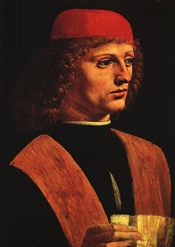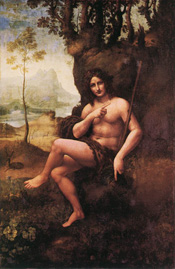| |  | Leonardo Da Vinci |  |
| "The first object of the painter is to make a flat plane appear as a body in relief and projecting from that plane." *** Leonardo Da Vinci (1452-1519) was an Italian painter, draftsman, sculptor, architect, and engineer whose genius, perhaps more than that of any other figure, epitomized the Renaissance humanist ideal. His "Last Supper" (1495-97) and "Mona Lisa" (1503-06) are among the most widely popular and influential paintings of the Renaissance. His notebooks reveal a spirit of scientific inquiry and a mechanical inventiveness that were centuries ahead of his time. |  |
By a happy chance, a common theme links the lives of four of the famous masters of the High Renaissance: Leonardo, Michelangelo, Raphael and Titian. Each began his artistic career with an apprenticeship to a painter who was already of good standing, and each took the same path of first accepting, then transcending, the influence of his first master. The first of these, Leonardo da Vinci (1452-1519), was the elder of the two Florentine masters. He was taught by Andrea del Verrocchio (1435-88), an engaging painter whose great achievement was his sculpture. Verrocchio's best-known painting is the famous "Baptism of Christ", famous because the youthful Leonardo is said to have painted the dreamy and romantic angel on the far left. There has never been an artist who was more fittingly, and without qualification, described as a genius. Like Shakespeare, Leonardo came from an insignificant background and rose to universal acclaim. Leonardo was the illegitimate son of a local lawyer in the small town of Vinci in the Tuscan region. His father acknowledged him and paid for his training, but we may wonder whether the strangely self-sufficient tone of Leonardo's mind was not perhaps affected by his early ambiguity of status. The definitive polymath, he had almost too many gifts, including superlative male beauty, a splendid singing voice, magnificent physique, mathematical excellence, scientific daring... the list is endless. This overabundance of talents caused him to treat his artistry lightly, seldom finishing a picture, and sometimes making rash technical experiments. "The Last Supper", in the church of Santa Maria delle Grazie in Milan, for example, has almost vanished, so inadequate were his innovations in fresco preparation. Yet the works what we have salvaged remain the most dazzlingly poetic pictures ever created. The "Mona Lisa" has the innocent disadvantage of being too famous. It can only be seen behind thick glass in a heaving crowd of awe-stuck sightseers. It has been reproduced in every conceivable medium: it remains intact in its magic, for ever defying the human insistence on comprehending. It is a work that we can only gaze at in silence. We can always tell a Leonardo work by his treatment of hair, angelic in its fineness, and by the lack of any rigidity of contour. One form glides imperceptibly into another (the Italian term is sfumato), a wonder of glazes creating the most subtle of transitions between tones and shapes. Also, under Rembrandt's shadow, painters flourished to the extent that we can no longer distinguish their work from his own. But Leonardo's was a chilling shadow, too deep, too dark, too overpowering. When Leonardo was not painting he was designing. As a military genius he designed weapons which were far ahead of their time, such as the multi-barrel gun and the crossbow machine. As an engineer he designed spring devices and water diversion systems. As a geologist he accurately described stratification and fossilization. His drawings and sketches of human anatomy are still admired by physicians for their detail and accuracy. His flying machines are the most prophetic of all his inventions. His sketches of the helicopter in particular serve to magnify the genius of Leonardo; he truly was a man far ahead of his time. The world continues to marvel at the genius of Leonardo da Vinci and his prophetic ability to project the world of the Renaissance into the future. He truly was, and is, a masterpiece of human creation. |
|
| |
|  | | "Portrait of Mona Lisa" (also known as La Gioconda, the wife of Francesco del Giocondo, 1503-06) Oil on wood, 77 x 53 cm - 30 x 20 7/8 in. Musée du Louvre, Paris, France. | |  | 
|  |  | "The Last Supper" (1498) Fresco, 460 x 880 cm - 15 x 29 ft. Convent of Santa Maria delle Grazie, Milan, Italy. | | | 
|  |  | Study of Proportions (from Vitruvius's De Architectura) Pen and ink, 34.3 x 24.5 cm- 13 1/2 x 9 5/8 in. Accademia, Venice, Italy. | |  | 
|  |  | "Annunciation" (1472-75) Tempera on wood, 217 x 98 cm - 85.4 x 38.6 in. Galleria degli Uffizi, Florence, Italy. | | | 
|  |  | "Virgin of the Rocks" (1506) Oil on wood, 120 x 189.5 cm - 47.2 x 74.6 in. National Gallery, London, UK. | | | 
|  |  | "Madonna Litta" (circa 1490-91) Tempera on canvas, transferred, 33 x 42 cm - 12.99 x 16.54 in. Hermitage, St Petersburg, Russia. | | | 
|  |  | "Portrait of a Musician" (1490) Oil on panel, 31 x 43 cm - 12.2 x 16.93 in. Pinacoteca Ambrosiana, Milan, Italy. | |  | 
|  |  | "The Madonna of the Carnation" (1478-1480) Oil on panel, 47.5 x 62 cm - 18.7 x 24.41" in. Alte Pinakothek, Munich, Germany. | | | 
|  |  | "St John in the Wilderness" (1510-15) Oil on panel transferred to canvas, 115 x 177 cm - 45.3 x 69.7 in. Musée du Louvre, Paris, France. | |  | 
|  |  | "St John the Baptist" (1513-16) Oil on panel, 57 x 69 cm - 22.44 x 27.17 in. Musée du Louvre, Paris, France. | | | 
|  |  | "Portrait of Cecilia Gallerani" (1483-90) Oil on wood, 40.3 x 54.8 cm - 15.87 x 21.57 in. Czartoryski Museum, Cracow, Poland. | | | 
|  |  | Study of battles on horseback (1503-04) Pen and ink. Galleria degli Uffizi, Florence, Italy. |
| Text source: 'Webmuseum' (www.ibiblio.org/wm). |
|  | "Francis I of France receiving the last breath of Leonardo da Vinci" (1818) Ingres | |
 | share this page (aged 13 or over only) |
| | |
|
|
|